#Charles Boles
Explore tagged Tumblr posts
Text

John Boles and Charles Farrell in an original publicity still for Fazil (1928)
0 notes
Text

Best Short Stories by Negro Writers: An Anthology from 1899 to the Present, Edited and with an Introduction by Langston Hughes, Little, Brown and Company, Boston, MA, 1967

Feat.: Alston Anderson, James Baldwin, Lebert Bethune, Robert Boles, Arna Bontemps, Gwendolyn Brooks, Frank London Brown, Charles W. Chesnutt, Alice Childress, John Henry Clarke, Cyrus Colter, Pearl Crayton, Owen Dodson, Paul Laurence Dunbar, Katherine Dunham, Junius Edwards, Ralph Ellison, Ronald Fair, Rudolph Fisher, Ernest J. Gaines, Chester B. Himes, Langston Hughes, Kristin Hunter, Zora Neale Hurston, Clifford Vincent Johnson, William Melvin Kelley, John Oliver Killens, Woodie King, Jr., Sylvester Leaks, Paule Marshall, R. J. Meaddough III, Ronald Milner, Willard Motley, Lindsay Patterson, Ted Poston, Conrad Kent Rivers, Charlie Russell, Mike Thelwell, Jean Toomer, Mary Elizabeth Vroman, Alice Walker, Eric Walrond, Dorothy West, John A. Williams, Charles Wright, Richard Wright, Frank Yerby
Plus: Anthologies of African American Writing, Mason Libraries Omeka Portal, George Mason University, Fairfax, VA
#graphic design#typography#book#cover#book cover#langston hughes#little brown and company#anthologies of african american writing#mason libraries omeka portal#1960s
23 notes
·
View notes
Text
a spin-off of this poll from @humandisorderincarnatedean
full list below
other one-off* directors are:
David Jackson (1x07 Hook Man)
Paul Shapiro (1x13 Route 666)
Chris Long (1x17 Hell House)
Tony Wharmby (1x20 Dead Man’s Blood)
Whitney Ransick (1x18 Something Wicked)
Tim Iacofano (2x05 Simon Said)
Bradford May (2x15 Tall Tales)
Adam Kane (4x13 After School Special)
Rick Bota (5x19 Hammer of the Gods)
Jan Eliasberg (6x06 You Can’t Handle the Truth)
David Barrett (6x13 Unforgiven)
Charles Robert Carner (8x07 A Little Slice of Kevin)
Nick Copus (8x09 Citizen Fang)
Kevin Hooks (9x03 I’m No Angel)
Rob Spera (9x06 Heaven Can’t Wait)
Misha Collins (9x17 Mother’s Little Helper)
Darren Grant (14x05 Nightmare Logic)
John Fitzpatrick (14x16 Don’t Go In the Woods)
*pour one out for robbie duncan mcneill who is the reason i wanted to make this poll because of everything going on in 1x06 skin but it turns out he also directed the great escapist! thank you for your service!
#I called it at ten to keep the poll from getting too long but still wanted to find a way to include the whole#list#unsurprisingly the one-offs are more heavily weighted to the early seasons but it is WILD to me that they brought in someone new#to direct the third last episode of the series#spn#spn polls#spnblr
51 notes
·
View notes
Text
Social outcasts from Columbine High School who banded together in a sea of pecking orders and cliques. The informal club was founded after Thaddeus "Tad" Boles received a trench coat from his mother for Christmas in 1996.

Roughly a week later, his close friend Chris Morris got a similar coat. Joseph "Joe" Stair soon followed suit. Pretty soon, almost all of Boles' friends were wearing them, including John Beachem, Eric Dutro, and Cory Friesen. Other core members included Charles "Chuck" Phillips Jr., Horst Rossmueller, Brian Sargent, Robert Perry, and Patrick McDuffee. Other associates of the group included Josh Barnes, Eric Jackson, Andy Thomas, Robyn Anderson, Nate Dykeman, Pauline Colby, Kristen Theibault, Krista Hanley, Alex Marsh, Devon Adams, Erin Adams, Nicole Markham, Jessica Rusch, Nicole Dickey, Abigail Boles, Zach Heckler, Chris Tibaldo, Kristi Epling, and Nate Epling.

General consensus holds that the group got its name after kids at school teasingly said: "Oh, here comes the trench coat mafia". The teens refused to be ruffled by the title. Instead, they adopted it proudly. They were the gamers and 'weird' kids; the ones who didn't fit in, whether unintentionally or deliberately. And they had found their niche.
#tccblr#tcc tumblr#tcc columbine#trench coat mafia#trenchcoat mafia#tad boles#chris morris#robyn anderson#nate dykeman#devon adams#zach heckler
10 notes
·
View notes
Note
Lowky kinda nervous to request but.. Yandere Arthur Morgan hcs? (high-honor preferably) read some other people’s take on Yandere Arthur and I’m curious about yours:)?
Have good day/night! Love your writing also❤️❤️
yessir!! Thank you!! Here's my take on him

Yandere! High Honor! Arthur Morgan hcs
Warnings: Gender neutral darling, yandere trope, major spoilers for rdr2, terminal illness, death (Arthur), obsession, stalking, overprotective behavior, manipulation, smothering behavior at times, semi-lucid yandere, possibility of kidnapping



Main traits: |Overprotective/lucid/patient/desperate|
✘ Well heres my thoughts, a lotta of em, worded as best as I can for a complex character like him. First off, he's one of the "better ones" to have, especially considering we're talking high honor here folks.
✘ Like a many characters I don't imagine this obsession is gonna appear outta thin air, it has to have a basis. Meaning you're once more in the gang, probably been there for years at that point alongside Arthur. Longer you been around the stronger the obsession.
✘ Starts as a faint crush here and there over the years, some closeness he dosen't quite show with some gang members like Javier or Sean, but probably more along the likeness of Charles and John. Yet nothing too out of the ordinary.
✘ Now when the game starts, Dutch starts slipping, bodies dropping, and more and kore extreme leaps.. that's where the obsession picks up. Kicks in fully later when his thing with Mary fully ends.
✘ After Sean's death he's more atnsy, wanting to stick beside you a bit more on missions, back to back with you during gunfire. Something that seems reasonable. It turns into him outright trying to stop you from going on certain missions.
✘ He tries to reason he and the others can handle it, you should stay behind and look over camp, you'll still be helping that way. If you still come along he's beside you as much as possible.. especially if Micah is on it. Oh Micah he glares at and grumbles under his breath ig Micah tries anything with you. Barking at Micah to leave you alone on your behalf.
✘ He starts to doodle and fantasize about you in his journal, portraits of you, drawings of you going about doing things, sketches of you in action during a fight from his memory. More and more each day, each night, the thing might as well be a shrine to ya.
✘ He stalks to follow you on your own outings. just from a distance.. making sure you're safe. Magically showing up when you're in danger. Bumping into you in the city. If he's confronted he gets all akward, brushing it off with some hand sways and lighthearted jokes.
✘ He persuades and if he needs to intimidates people away from you. Particularly folks like Micahs friends, drunkards at a bar, or people getting in your way. Violence ain't entirely out the question but he ain't jump the guns blazin violent.
✘ Chapter 5? Oh no. Chapter 5 when he gets diagnosed with tuberculosis? His world is spiraling twice over. His fantasies of living out a long life with you are shot down. That won't stop him. He wants.. he needs to spend as much time as he can with you. He wants his last dying moments to be with you.
✘ He's insistent on talking to you about Dutch, implying leaving the gang together.. earlier than the final mission of the game. Trying to sway you, pleade, this whole things in shambles, won't you just go with him? You can find a little cabin to settle down and hide in.. or something. Please.
✘ He's even more glued to you side. Conflicted. This isn't right to try to chain you to him.. but he's going to die anyways isn't he? You'll be rid of him once he's gone cold. But does he really want your last impression of him to be a possessive bastard? No.. he dosen't.. but he might.
✘ In the case it comes to a boling point.. he pulls out his lasso and hogties ya. Dragging you off to one of the abandoned cabin in the wilderness. Pleading with you, apologizing the whole time, please.. won't you grant a dying man's last wish?
✘ He might attempt to use his condition to guilt trip you without realizing he's doing it himself. Everything he's done for you, clinging to you, spewing out jumbled words his of feelings in an attempt to make you understand.. or to make you flee.
✘ There's a good chance he let's you run free. He dosen't want you to die just because he wanted to keep you with him. He dosen't want you miserable or buied because of his selfishness. He wants to do something good for before he leaves. Helping you flee like he does with John.

18 notes
·
View notes
Text
Today in Christian History

Today is Friday, February 23rd, 2024. It is the 54th day of the year in the Gregorian calendar; Because it is a leap year, 312 days remain until the end of the year.
1680: Death of Thomas Goodwin (pictured above), a notable English Congregational Nonconformist preacher. He had been a member of the Westminster Assembly of 1650, and author of many biblical and theological works. His last words were: “Ah, is this dying? How I have dreaded as an enemy this smiling friend.”
1719: Death in Tranquebar, India, of thirty-six-year-old Bartholomew Ziegenbalg, missionary to India, who has established a seminary, translated the New Testament into Tamil, converted and baptized over two hundred Indians, and constructed a church building. At one point he had been imprisoned by the Dutch who feared his preaching would antagonize the Hindus they administered.
1758: Jonathan Edwards receives a smallpox vaccination from which he contracts the disease. He will die in March.
1819: A new church at Friedensthal on St. Croix Island is consecrated to the worship of the living God by Moravians and their converts. The congregation is so numerous not a third part can get inside the doors.
1846: Following the outrage raised by his publication of “Remarks on Certain Passages in the Thirty-Nine Articles,” in which he has tried to reconcile Church of England teaching with Roman positions, and his migration to the Roman Catholic church, John Henry Newman leaves Oxford for good.
1855: John Bright, a Quaker-born Christian parliamentarian in England, makes an eloquent speech against the Crimean War. Its most famous line is, the “Angel of Death has Been Abroad.”
1918: The body of the Orthodox priest George Porgachevsky is found about a mile and a quarter from the village of Ivanovskoye, Amur region. His head is crushed and he has two bayonet wounds in his stomach. The Soviets had arrested him thirteen days earlier.
1925: Death in Alexandria, Virginia, of Kate Waller Barrett, an American physician, who, as a single mother and member of the Episcopal Church, co-founded the National Florence Crittenton Mission financed by wealthy Charles Nelson Crittenton. She had secured for the mission the first-ever federal charter for a charitable organization.
1929: Lindel Tsen is consecrated as Assistant Bishop of Honan, the first Chinese bishop in an established Anglican diocese. He will become the principal leader of Chinese Anglicanism in the mid-20th century and suffer persecution at the hands of the government.
1934: Death in Baltimore, Maryland, of Peter Ainslie, a Disciples of Christ minister, ecumenical leader, and author of The Scandal of Christianity, a sharp rebuke of divisions among Christians.
1951: Death of Zhang Boling (Chang Po-ling), a prominent Chinese Protestant layman and educator. He had been affiliated with the YMCA, founded Nankai University, accepted women for education, and promoted athletic activities. Because of the school’s patriotism the Japanese had bombed and burned it and succeeding political changes made him unwelcome.
6 notes
·
View notes
Text
Lets talk about Purgatory... (2)
Last time, we talked about how the belief in the existence of a Purgatory, as a third realm between heaven and hell, slowly came into existence and was ultimately accepted by the Church - but it stayed a vague, undefined realm with very little canonical or official statements about it. And we were about to see how what actually TRULY helped Purgatory grow and develop itself was popular imagination, non-religious texts and other forms of art...
As a reminder, I am still following so far for these posts an article that was written by Christine Duthoit about the beliefs in the afterlife during the Middle-Ages.
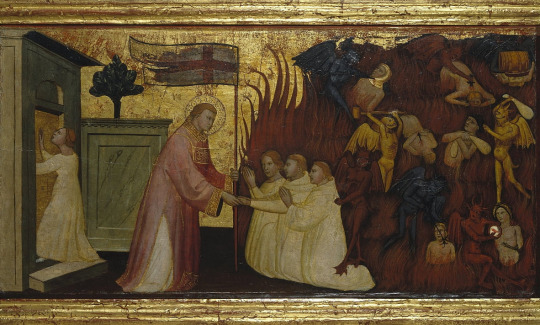
So, as we said, the fact that theologians were very vague, uncertain and brief whenever they spoke of Purgatory was a true obstacle for many artists of the time who wishe to depict this realm, and it didn't help that in the many afterlife visions they had to take inspiration from, Purgatory and Hell were clearly confused with each other, or looking extremely similar. Take the vision of Charles the Fat, in the ninth century (I briefly referenced it in the previous post). In this vision, Charles was guided by a being dressed in white, and holding a sort of shining ball emitting a strong ray of light. The guide took Charles into what is described as a "maze of hellish torments": he saw great and deep valleys of fire filled with wells in which were burning sulfur, lead, wax, soot and pitch. And in this place, souls were tortured inside boiling rivers and boling swamps ; as well as within "furnaces of pitch and sulfur, filled with great dragons, scorpions and snakes of many different species". Is it Purgatory or Hell? Hard to say. Saint Augustine was also considered to have been one of the main Christian voices behind the "infernalization" of Purgatory. And, just like with Hell, the dominating element of Purgatory is fire: descriptions are filled with fire-rings, fire-circles, fire lakes, seas of fires, walls of fire, burning valleys, hot coals, mountains of flames... However, unlike the fire of Hell which is only suffering and pain, the fire of Purgatory is meant to be purifying: it notably makes one look younger, and offers a form of immortality. This association of Purgatory with fire explains why many thought the volcanic regions were gateways to Purgatory - the Etna in Sicily, or the islands Lipari, were believed to host Purgatory. And of course, there is "Saint Patrick's well" in Ireland...
In the 12th century, four "visions of the afterlife" dominated the European beliefs and culture. Three of them are only evoked in the article but not described in details: the vison of the mother of Guibert of Nogent ; the vision of Tnugdal ; the vision of Alberic of Settefrati... As for the fourth, it is the one collected in the medieval best-seller that was The Purgatory of saint Patrick, written between 1190 and 1210. In this tale, a Cistercian monk of England named Gilbert is sent alongside a knight named Owein to build a monastery in Ireland. The story describes how the future saint Patrick, who was in the middle of Christianizing Ireland, was showed by Jesus a well... Not just any well. A round, dark and deep well located in the Red Lake (Donegal), on Station Island ; and Jesus told saint Patrick that any Christian that would spend a day and a night in this hole would be purged of all their sins - and they would also be able to see the suffering of the wicked and the joy of the virtuous. Saint Patrick had a church built nearby, and a great wall erected around the well, trusting the key of the door's wall to an abbot (mentions of this geography are found in the maps of Topography of Ireland by Giraud the Welsh). Owein, the knight, decides to go down the well, despite him having quite a handful of sins weighing his souls, and despite the warning of the churchmen that guard the well. As soon as he gets down into the hole, he is harassed by numerous demons, and forced to walk in a mix of pure darkness and red lights, filled with tormented screams and fetid smells. The red lights come from the flames of a pace that looks like Hell - and is inhabited by dragons, snakes and toads that constantly torment the souls there. Owein sees people being crucified with red-hot nails, being tied up to fiery wheels, being roasted or hanged by iron-hooks, he even sees people being plunged in huge vats of molten metal... Owein manages to face all the horrors and trials of what he beleves is Hell, by constantly invoking the name of Jesus to protect him. He ends up arriving in what seems to be Earthly Paradise, and is there welcomed by two archbishops... Who reveal to him it wasn't Hell at the bottom of the well. But Purgatory, explicitely referred to as the "third realm" of the afterlife, and where the souls of the sinners complete their repentance and purification. Once the souls of Purgatory are done with their torments, they will reach the Earthly Paradise, and then finally move on to the celestial Heaven. The knight returns to the top of the well, and upon reaching back the world of the living is glad to learn he has been purified of all of his sins.
This story became MASSIVELY popular in medieval Europe - notably because it confirmed what many people wanted to believe into, the idea that the justs and good people had a chance to completely and utterly purify themselves before reaching Heaven. By extension, it meant there were indeed various types and categories of sins, and that not all crimes were as bad - with some sins being forgivable and not preventing one's reach of Heaven...

Another key feature to understand the "creation" of Purgatory in the Christian world is the idea that the dead and the living are somehow tied to each other.
The article begins by the "communion of the saints". This belief did not originate in any actual council or official Church decision - rather, in France, it spontaneously appeared at the end of the 4th century among the Christian communities. The saints weren't just protecting and watching over the living anymore ; now, they formed a bridge and a link between the living and the dead. Most importantly, the sufferings and pains of the dead in the afterlife could be eased or shortened by the prayers of the living - through the saint, that received the prayer, and then influenced the fate of the deceased. (In France we call those interventions for the dead caused by the living's prayers "suffrages").
The apparition of the idea that the prayers of the living influenced the afterlife was part of a wider movement in Christianity that focused more and more about the dead. Take the apparition of All Hallows Day, or All Saints Day. It was created in 610 by Boniface IV, and it was originally the day of the martys - and solely the martyrs. But then it became the day to celebrate all of the saints, martyrs or not martyrs - and Gregory the IV insisted on this day being celebrated by all Christians, showing the importance it grew. In parallel, we know that as early as Gregory the Great's time, masses and religious celebrations included a "Mementa", a part to remember the dead. This expanded into the monks creating "Libri Vitae", to register all the livings and the dead that were named during a mass ; and soon necrologies and obituaries were formed, lists and registers of the deads, their names, the day they died, and their "obit", the anniversary of their deaths. And between 1024 and 1033, a Day of the Dead was created to honor and commemorate all the dead Christians... And it was placed on the second day of November, that is to say the day following All Hallows Day/All Saints Day, further strengthening the bond between the Saints and the Afterlife.
As new conceptions of sin and penitence appeared, as the confession became one of the most important rituals in the life of the Christians, stories and testimonies of deceased coming back to visit the living (usually souls from Purgatory) started multiplying. You had dead people visiting their family to demand their prayers and their memory in the afterlife ; you had dead churchmen or churchwomen informing the people of their order of what happened to them in the afterlife ; mystics and saints kept being visited by ghosts and revenants left and rights. This was a good bulk of the story of hauntings in the Middle-Ages. A greater focus was put on the idea that a Christian had to absolutely purify themselves when alive to avoid the torments of the afterlife - notably through contrition, confession and penitence. The pope Innocent III had a very cynical take on the mental beliefs and evolutions of his time, pointing out that the living only cared for the dead, because they themselves were future dead. Aka, this obsession with Purgatory and ghosts and praying for the dead was simply the other side of the coin of the fear of mortality, and the terror of the trials awaiting beyond.

In the middle of the 13th century, when it came to Churchmen that took care of the fidels and shared their daily life, the Cistercians were replaced by the Mendicant orders, the "begging monks", who were especially popular/influental in urban areas. One of the specific traits was a heavy use of "exempla" during their preach: the "exemplum" is, as the name indicates, an example, the illustration of an affirmation or claim, taking the shape of a small story. It ranges from the parable to the fable, passing by actual ancestors of what we know today as "fairytales". And it is within these exempla that the legend of Purgatory ended up being built (a good example of the results of this "exampla-fashion" is the Golden Legend, La Légende Dorée of Jacques of Voragine).
A man the article speaks heavily about is the Dominican named Thomas of Cantimpré. He was a general-preacher for a monastical province that covered a part of Germany, a part of Belgium and a part of France. After spending thirty years preaching and teaching Christianity, he collected an enormous amount of exempla in his "Livre des abeilles", The Book of bees - and this collection testifies the strong anguish and terror Christians felt at the time when it came to death and the afterlife. They also record how comforting and beloved the idea of the "suffrages", of the power of the living over the fate of the dead, was. Thomas of Cantimpré notably classified six types of "suffrages" that could ease the pain or shorten the torment of the souls in Purgatory: tears (crying for the dead), the wakes (watching over the deceased), fasting (respecting a funeral fast), alms (aka giving money to someone who will think about/pray for the dead), the "sacrifice of the mass" (aka having a funeral mass for the dead), and giving back money (aka, either paying the debts of the deceased, either restituting goods or wealth that the dead stole). This belief was certainly influenced by how Thomas of Cantimpré wrote an official biography of saint Lutgarde of Tongres, a cistercienne nun who devoted her entire life to the souls of the Purgatory, constantly praying and fasting for them.
The article offers a selection of the Purgatory-exempla that Thomas of Cantimpré wrote down.
A) A very sick man prays God so he can be set free from his ill body by death. An angel appears and offers him a choice: either be sick for a whole year and go directly to Heaven, or die now and spend three days in Purgatory. The sick man says he prefers dying now and suffering Purgatory: he dies and finds himself in the middle of cruel torments. After one year of torture, the angel comes back to him and asks him "Do you think you made the right choice?". As the soul of the dead complains about his situation, the angel reveals to him this one year... was actually one day in Purgatory. The dead man eventually agrees to take the other option - he is sent back into his sick body, and suffers his illness for one more year before going to Heaven.
B) A wealthy and powerful duke decides to convert himself to Christianity. He stops spending too much, he is very charitable to the poors of his domain, he has chapels built to celebrate masses "in honor of the souls suffering in Purgatory". The devil, angry at this, causes a rebellion and uprising among the duke's vassals. They accuse their lord of believing imaginary stories, of spending his money in a "dishonorable" way, and to not care about the noble serving under him anymore, giving all his wealth to the dead rather than the livng. This becomes a civil war, but the battle is ultimately won by the duke because he is helped by a celestial army coming down from Heaven - and made by all the souls that could escape Purgatory thanks to the duke's alms and masses.
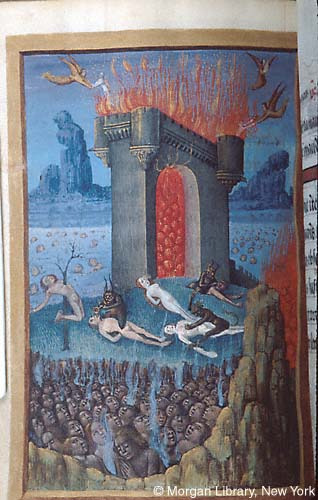
The "officialization" of Purgatory only appears with the second Council of Lyon, organized in 1274: it is then that the Purgatory became an official belief of the Christian Church. The Purgatory is seen as an extension or substitution to the earthly penitence of the living. It is stated that the duration of a stay in Purgatory depends from person to person - but that it does not have to cover all of the span between someone's death and the resurrection at the end of times (aka, a Purgatory soul can reach Heaven before Judgement Day). Starting from this Council onward, theologians started making complex and fascinating calculations in order to determine how long exactly a soul has to stay in Purgatory, depending on the quantity and gravity of the person's sins.
And with any religous process that involves the metaphysical equivalent of math tests... cheating arrived. In the form of "indulgences". For those of you not familiar with this, the system of indulgences within the Christian Church (Catholic branch) is, as the name says, a system of "pardons" and "leniences" - it is when a Catholic religious authority deserves a form of "pardon" for the sins of a specific person. At first it was another way for living Christians to purify themselves before their death - and it quickly became one of the most famous corruptions of the Church, denounced as much by Protestants as by poets such as Dante. Sinners just had to "buy" an indulgence by giving enough money to a religious authority, and they were cleansed of their crimes in the eyes of the Church - even if they made no effort to redeem themselves, underwent no penitence or did not express any regret. But by the hubilee of the Church in 1300, the Pope Boniface VIII extended the indulgences to the souls of Purgatory - which by the time had become a full part of the Christian art and Christian rituals.
And when Protestantism arose, the Catholic Church held tightly onto the belief in Purgatory: in the 16th century, the Council of Trente confirmed once more that Purgatory was part of their canon and dogma, to better differentiate Catholics from Protestants.
Fascinatingly however, it was not the first time Purgatory served a political purpose... Long before Protestanism appeared, Purgatory had been used as a tool against all those seen as dissidents groups within the Church - aka, heretics. In France, the two most famous heresies of the Middle-Ages firmly rejected Purgatory as a whole. One was the one we called the "vaudois", part of the Vaudois movement (also called Valdeism or Valdism). They held the belief that faith was a gift from God, and that by extension only the Christ could intercede. As in, only prayers to the Christ had any power to change the fate of people or could be able to reach God - by extension, they considered that the saints were powerless, and the indulgences worth nothing. Recognizing only two sacraments as "real", the Baptism and the Eucharist, they considered Purgatory to be a pure fiction, a made-up fairytale with no real existence: for them, there is only Heaven or Hell.
The other group were, of course, the Cathars, who believed that material world was inherently evil and that humans were fallen angels trapped in bodies of flesh. They only recognized one sacrament, the "consolamentum", the only ritual that can grant salvation by setting free the divine part of the human: the spirit returned to God, leaving behind its material body and the evil within it. This ritual, called a "baptism of spirit and fire" was a cross between the "last rites" for the dead (as it was the final ritual ensuring salvation after death), and an ordination, as it was the only ritual needed to become fully and "truly" Christian. Hence why the Cathars called themselves the Perfects, the Good Men or the Good Women (they also heavily used the Gospel of John, which fitted the most their beliefs). As a result of all this - for them death, like with the vaudois, could only lead to Hell (being trapped in the material world) or Heaven (becoming a pure spirit with God) - no in-between was possible.
A third group deemed as heretical by the Church that also rejected Purgatory were the Brothers and Sisters of the Free-Spirit, the Libre-Esprit movement, who preached and swore only by poverty. For them, it was poverty that set a man free of his sins and "resurrected the Christ within him". Long story short: as long as you were poor, you could listen to your every desires and follow your every whims without fearing a sin. This was the teaching of the "free-spirit": you could obtain paradise by simply living on earth, as long as you were poor, since poverty annihilated all sins. In their own words, a poor whore was worth more than a pious and just rich man - and in turn, this allowed them to declare all Churchmen were damned (denouncing how the Church had become one the wealthiest institutions of the Middle-Ages).
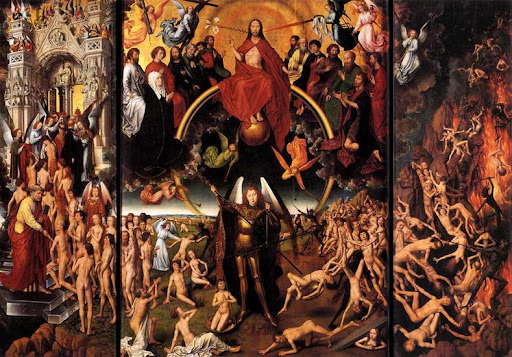
This is all I can take from the article - and unfortunately it is quite limited, since the text is about Purgatory in the Middle-Ages, and so it does not expand to modern days... But I hope it was interesting eough as a quick overview! If I find more sources, I'll continue this series.
#purgatory#christianity#christian mythology#christian afterlife#history of christianity#heresies#heresy
4 notes
·
View notes
Text
THE 100 GREATEST SCREEN-PAIRS IN HISTORY OF WORLD CINEMA (@INDIES)!
.RAJESH KHANNA - MUMTAZ
.WALTER PIDGEON – GREER GARSON
.HUMPHREY BOGART – INGRID BERGMAN
.RICHARD BURTON – ELIZABETH TAYLOR
.ETHAN HAWKE – JULIE DELPY
.CHARLES CHAPLIN – EDNA PURVIANCE
.HUGH GRANT – JULIA ROBERTS
.KEANU REEVES – CARRIE-ANN MOSS
.RICHARD GERE - JULIA ROBERTS
.REX HARRISON – AUDREY HEPBURN
.CHARLES FARRELL – JANET GAYNOR
.CLARK GABLE – VIVIEN LEIGH
.UTTAM KUMAR – SUCHITRA SEN
.ROBERT REDFORD – BARBRA STREISAND
.DEV ANAND – WAHEEDA REHMAN
.CARY GRANT – INGRID BERGMAN
.KEANU REEVES – SANDRA BULLOCK
.GARY COOPER – INGRID BERGMAN
.JOSEPH FIENNES – GWYNETH PALTROW
.CHARLES BOYER – INGRID BERGMAN
.CARY GRANT – KATHERINE HEPBURN
.GURU DUTT – WAHEEDA REHMAN
.RAJESH KHANNA - TANUJA
.DILIP KUMAR - MADHUBALA
.TOM HANKS – MEG RYAN
.RAJESH KHANNA – SHARMILA TAGORE
.HUGH GRANT – RENEE ZELLWEGER
.SPENCOR TRACY – KATHERINE HEPBURN
.AMITABH BACHCHAN – PARVEEN BABI
.MICHEL PICCOLI – ROMY SCHNEIDER
.WOODY ALLEN – DIANE KEATON
.RAJESH KHANNA – REKHA
.MICHAEL DOUGLAS – GLENN CLOSE
.ALAIN DELON – ROMY SCHNEIDER
.ROD STEIGER – ROMY SCHNEIDER
.SHAMMI KAPOOR – ASHA PAREKH
.MARCELO MASTROIANNI – ROMY SCHNEIDER
.YVES MONTAND – SIMONE SIGNORET
.ALAIN DELON – ANNIE GIRARDOT
.JOHNNY DEPP – JULIETTE BINOCHE
.LAURENCE OLIVIER – VIVIEN LEIGH
.CLARK GABLE – JOAN CRAWFORD
.TREVOR HOWARD – CELIA JOHNSON
.PATRICK SWAYZE – JENNIFER GREY
.PREM NAZIR - SHEELA
.VINCENT CASSEL – MONICA BELLUCCI
.CLARK GABLE – AVA GARDNER
.JEAN-LOUIS TRINTIGNANT – ROMY SCHNEIDER
.JACK LEMMON – SHIRLEY MACLAINE
.HEATH LEDGER - JULIA STILES
.ANTHONY PERKINS – INGRID BERGMAN
.TOBEY MAGUIRE – KIRSTEN DUNST
.GREGORY PECK – AUDREY HEPBURN
.TOM CRUISE – RENEE ZELLWEGER
.AMITABH BACHCHAN - REKHA
.JAMES STEWART – MARGARET SULLAVAN
.RYAN GOSLING – RACHEL MCADAMS
.PRADEEP KUMAR – MEENA KUMARI
.ROBERT MONTGOMERY – ROSALIND RUSSELL
.JOHNNY DEPP – HELENA BONHAM CARTER
.BOBBY VERNON – GLORIA SWANSON
.DOUGLAS FAIRBANKS JR. – LORETTA YOUNG
.CLARK GABLE – CLAUDETTE COLBERT
.RAJESH KHANNA – ZEENAT AMAN
.GLENN FORD – GERALDINE PAGE
.LEONARDO DI CAPRIO – KATE WINSLET
.RAJESH KHANNA – ASHA PAREKH
.MEL GIBSON – CATHERINE MCCORMACK
.RAJ KAPOOR - NARGIS
.BRAD PITT – ANGELINA JOLIE
.CHRISTOPHER REEVE – MARGOT KIDDER
.CARY GRANT – SOPHIA LOREN
.SOUMITRA CHATTERJEE – MADHABI MUKHERJEE
.HUMPHREY BOGART – AUDREY HEPBURN
.SALMAN KHAN – AISHWARYA RAI
.ANTONIA BANDERAS – CATHERINE ZETA JONES
.RYAN O’ NEAL – BARBRA STREISAND
.JOHNNY DEPP – GWYNETH PALTROW
.MICHAEL DOUGLAS – KATHLEEN TURNER
.JAMES STEWART – CLAUDETTE COLBERT
.LAURENT MALET – ANNIE GIRARDOT
.DICK POWELL – OLIVIA DE HAVILLAND
.TOMMY STEELE – GERALDINE PAGE
.GEORGE BRENT – OLIVIA DE HAVILLAND
.MAURICE RONET – BRIGITTE BARDOT
.RAJESH KHANNA - SRIDEVI
.WILLIAM POWELL – MYRNA LOY
.ANTHONY PERKINS – ROMY SCHNEIDER
.MICKEY ROONEY – JUDY GARLAND
.RAJESH KHANNA - RAAKHEE
.SHAH RUKH KHAN - KAJOL
.RAAJ KUMAR – MEENA KUMARI
.MAHIPAL – ANITA GUHA
.RALPH FIENNES – JULIETTE BINOCHE
.ERROL FLYNN – OLIVIA DE HAVILLAND
.JOHN BOLES – BARBARA STANWYCK
.DHARMENDRA – MEENA KUMARI
.PETER FINCH – AUDREY HEPBURN
.MARLON BRANDO – KIM HUNTER
.MAURICE RONET – ROMY SCHNEIDER .



(P.S. - THE 2 PEOPLE WITH MOST ENTRIES IN THIS LIST, ARE-
RAJESH KHANNA OF INDIA WITH 8 ENTRIES, FOLLOWED BY ROMY SCHNEIDER OF AUSTRIA/FRANCE WITH 7 ENTRIES!)



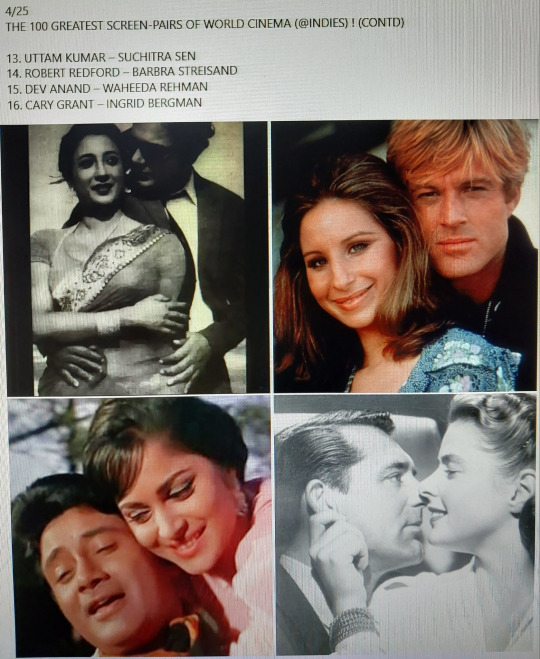
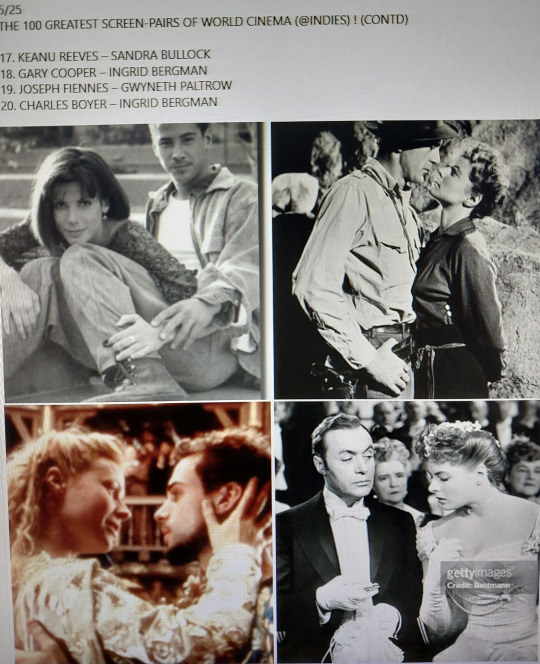
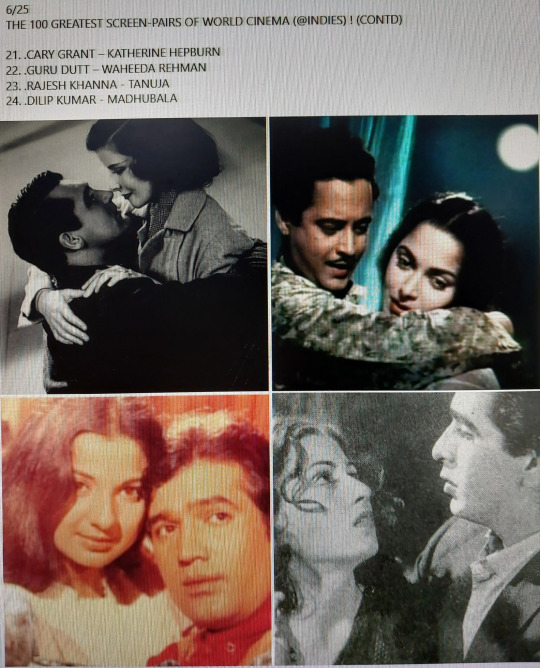


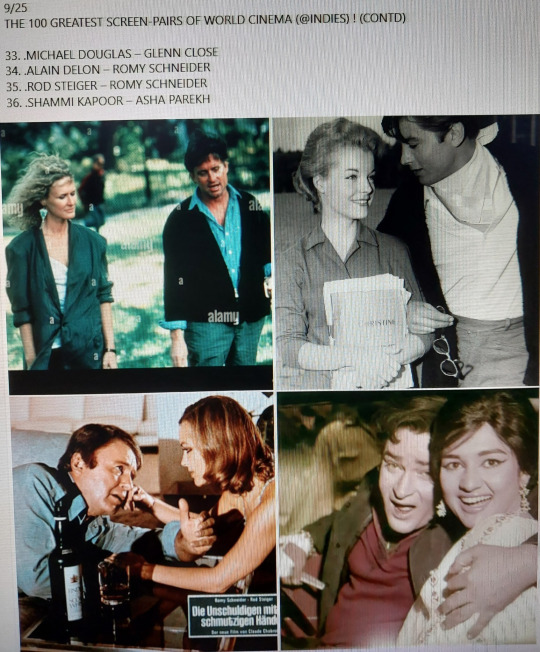

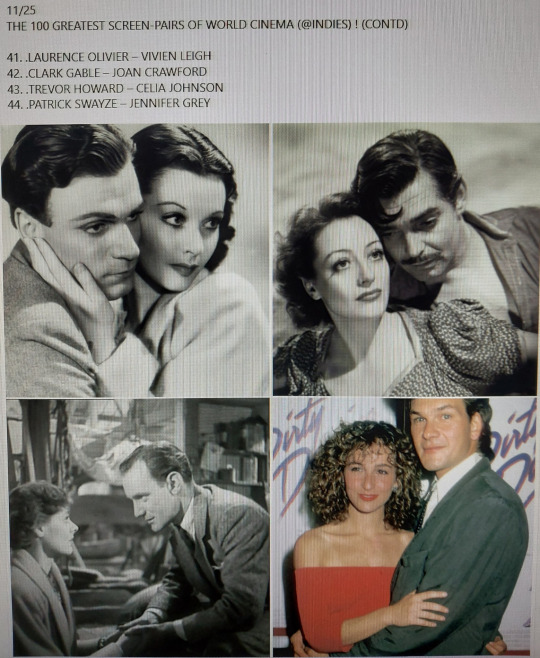


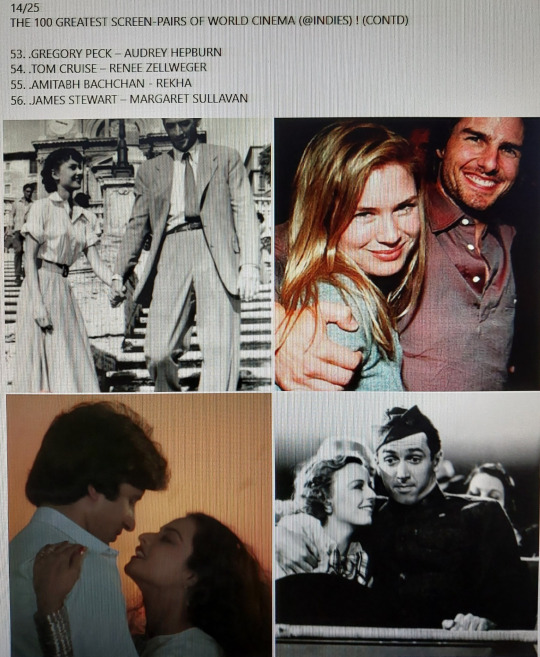

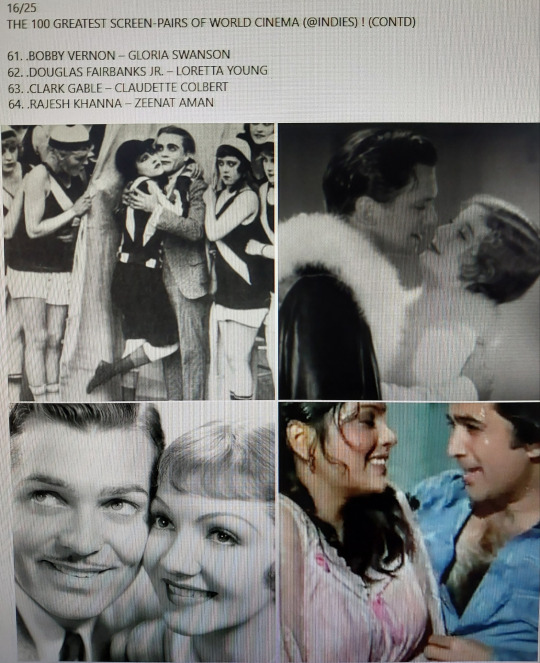
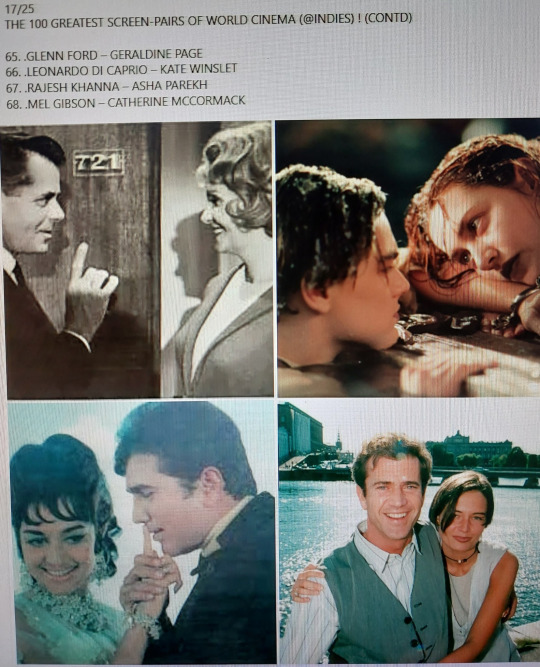
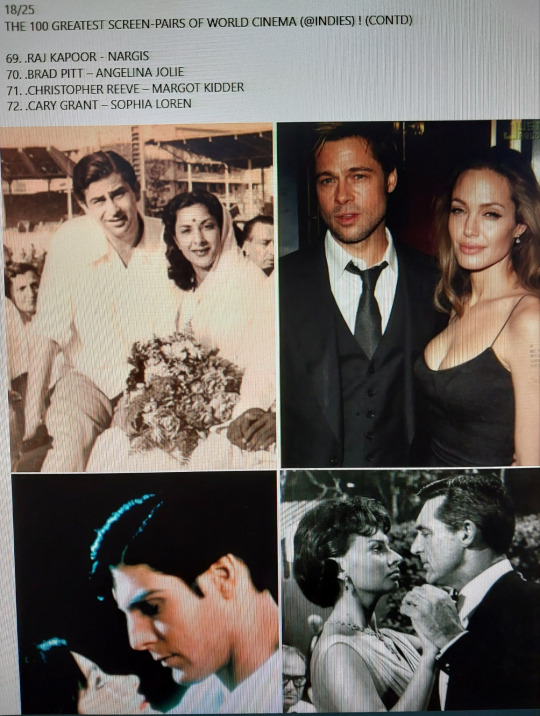
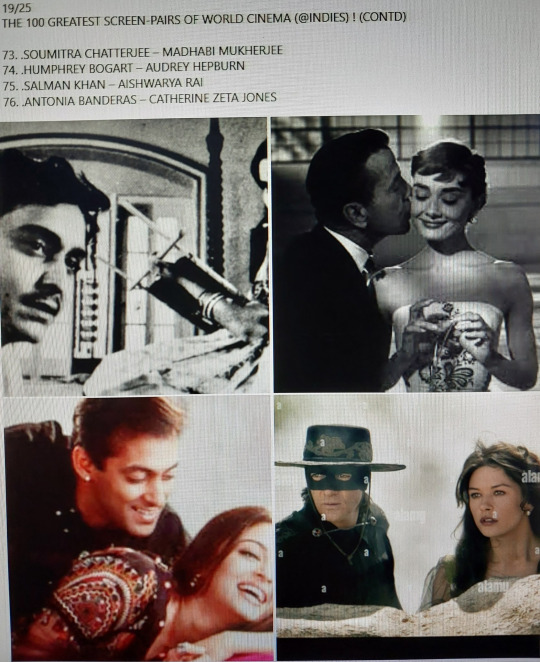


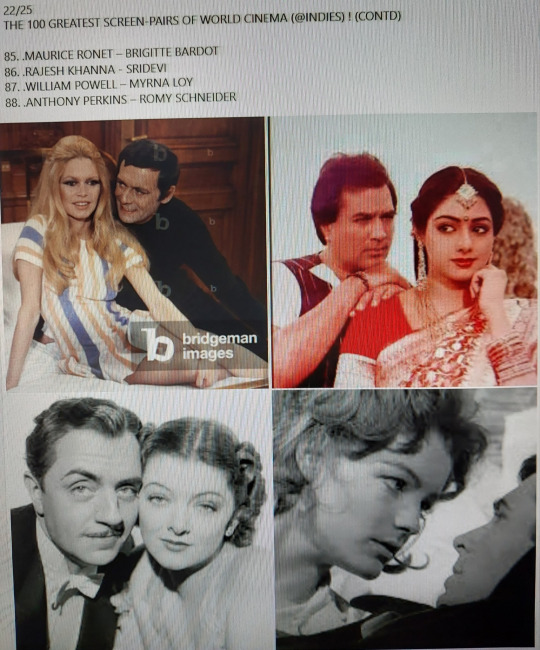


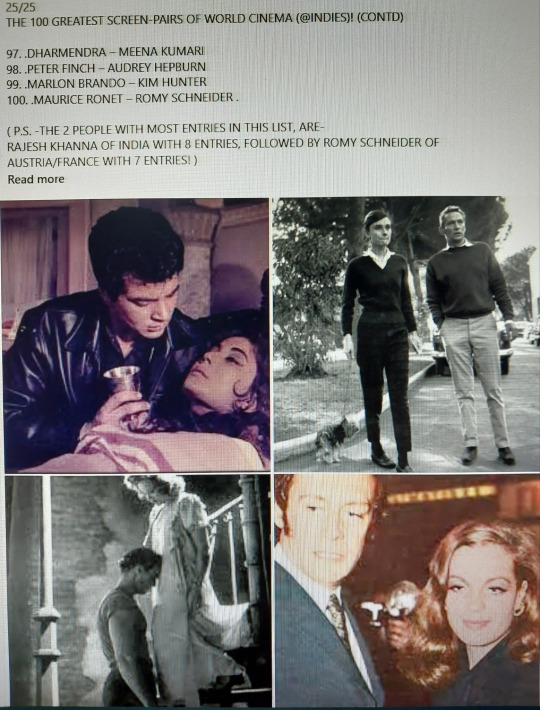
2 notes
·
View notes
Text
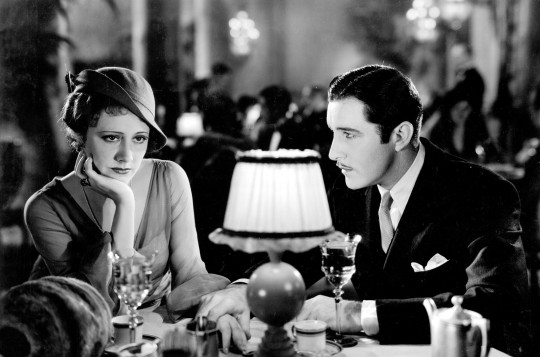
Irene Dunne and John Boles in Back Street (John M. Stahl, 1932)
Cast: Irene Dunne, John Boles, George Meeker, Zasu Pitts, June Clyde, William Bakewell, Arletta Duncan, Doris Lloyd, Paul Weigel, Jane Darwell, Shirley Grey, James Donlan, Walter Catlett, James McWade. Screenplay: Gladys Lehman, Lynn Starling, based on a novel by Fannie Hurst. Cinematography: Karl Freund. Art direction: Charles D. Hall. Film editing: Milton Carruth.
The 1932 version of Back Street (the first of three films Hollywood made from Fannie Hurst's novel) suggests that there are some things you couldn't say even in a pre-Code movie. Ray Schmidt (Irene Dunne) and Walter Saxel (John Boles) have fallen in love, but he's engaged to a woman of whom his mother approves. He thinks that if his mother meets Ray, she might be inclined to let him break off the engagement and marry her instead. But on the day of the scheduled meeting, Ray's sister, Freda (June Clyde), comes to her in distress: The man she's been seeing is leaving town and she desperately needs Ray's help in persuading him to stay. If he doesn't, she tells Ray, she'll kill herself -- and she opens a window to prove the point. Why is Freda so desperate? The answer becomes apparent with an exchange of Meaningful Glances: She's pregnant. The word or any of its variants is never spoken. So Ray misses the meeting with Mother and loses the chance to marry Walter. Years pass and Ray and Walter meet again, after he's married and become a wealthy businessman. He sets her up in an apartment as his mistress, which she tolerates for a time until she realizes what she's lacking in life and begs him, "Walter, give me a child." Walter is shocked at the very idea. The mechanics of an illicit sexual relationship, including the veiled subject of contraception, are summed up in the reticence around Freda's plight and Ray's plea to Walter, which sounds a bit like she wants him to go down to the baby store and pick one off the shelf. Euphemisms aside, your acceptance of the movie depends to some degree on whether you enjoy watching Dunne, an actress who can slip into coyness and archness. The film gives her a gamut to run, from the flirtatious Ray who likes to drink beer with the fellows in the early part of the film, to the nobly suffering kept woman of the later part. Boles is a little stiff in his role, though that rather suits the character. On the whole, Back Street is a solid "woman's picture" of the kind that would be treated with more life and color by filmmakers like Douglas Sirk in the 1950s.
3 notes
·
View notes
Photo
Frankenstein (James Whale, 1931)
Cast: Colin Clive, Mae Clarke, John Boles, Boris Karloff, Frederick Kerr, Dwight Frye, Edward Van Sloan, Lionel Belmore, Marilyn Harris. Screenplay: Garrett Fort, Francis Edward Faragoh, based on a story treatment by John L. Balderston of a play by Peggy Webling adapted from a novel by Mary Shelley. Cinematography: Arthur Edeson. Art direction: Charles D. Hall. Film editing: Clarence Kolster. Music: Bernhard Kaun.





Elizabeth’s wedding dress in Frankenstein (1931) Costume design by Vera West
2K notes
·
View notes
Text

John Boles and Charles Farrell in a publicity still for Fazil (1928)
0 notes
Text

24 January 2025
Film: SEED (dir. John Stahl, 1931, USA)
Forum: Film Studies Center Format: 35mm
Observations: This film was presented by a graduate student interested in the problem of copyright and derivative works. SEED originated as a best-selling 1930 novel by Charles Norris, brother of the more-famous Frank Norris. It was quickly adapted and put on screen by Universal, starring Genevieve Tobin and John Boles, but subsequent murky developments with the original copyright for the story has kept this film out of circulation ever since. (The print was a restoration from UCLA Film & Television Archive, struck in 2008.) The result has been no TV broadcasts, home video, or streaming access and only a handful of festival screenings. It's an absorbing film of its period, with resouceful use of off-screen sound for transitions. I expect that the film might see the light of day when the story enters public domain in the coming year. House was more than half full and projections was flawless.
1 note
·
View note
Text

Best Short Stories by Negro Writers: An Anthology from 1899 to the Present, Edited and with an Introduction by Langston Hughes, Little, Brown and Company, Boston, MA, (1967-)1969 [Perma-Bound] [Anthologies of African American Writing, Mason Libraries Omeka Portal, George Mason University, Fairfax, VA]
Feat.: Alston Anderson, James Baldwin, Lebert Bethune, Robert Boles, Arna Bontemps, Gwendolyn Brooks, Frank London Brown, Charles W. Chesnutt, Alice Childress, John Henry Clarke, Cyrus Colter, Pearl Crayton, Owen Dodson, Paul Laurence Dunbar, Katherine Dunham, Junius Edwards, Ralph Ellison, Ronald Fair, Rudolph Fisher, Ernest J. Gaines, Chester B. Himes, Langston Hughes, Kristin Hunter, Zora Neale Hurston, Clifford Vincent Johnson, William Melvin Kelley, John Oliver Killens, Woodie King, Jr., Sylvester Leaks, Paule Marshall, R. J. Meaddough III, Ronald Milner, Willard Motley, Lindsay Patterson, Ted Poston, Conrad Kent Rivers, Charlie Russell, Mike Thelwell, Jean Toomer, Mary Elizabeth Vroman, Alice Walker, Eric Walrond, Dorothy West, John A. Williams, Charles Wright, Richard Wright, Frank Yerby
#graphic design#typography#book#cover#book cover#langston hughes#little brown and company#anthologies of african american writing#mason libraries omeka portal#1960s
17 notes
·
View notes
Note
Rory Calhoun
Phillips Holmes
Robert Taylor
Steve Cochran
John Boles
Charles Farrell
THANKS~
You're very welcome!
They've been added and will be posted in the near future.
💖
1 note
·
View note
Text
Skyline Alabama Police Chief Shoots and Kills Man During Domestic Incident
Skyline, AL Police Chief Kyle Shelton responded to the address on Thursday where he was allegedly shot just inside the doorway by Charles David Boles. Chief Shelton returned fire, striking and killing Boles, according to Jackson County, Alabama Sheriff’s Office. Just before 5 p.m. Thursday, JCSO says they received a call about a domestic incident on County Road 143 in Skyline, Alabama. The…

View On WordPress
#Alabama#Alabama News#Bridgeport#Chattanooga News#Jackson County Alabama#Jackson County News#Jackson County Sheriff&039;s Department#Marion County News#Sequatchie Valley News#Skyline Alabama Police#Stevenson
0 notes
Text
Back Street

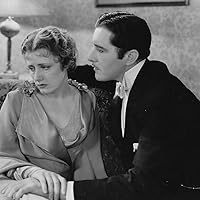
Call me cynical, but I’ve never had much patience for the plot of BACK STREET. The woman who lives without job or friends and even gives up a wealthy suitor so she can be the kept plaything of a wealthy businessman who neglects her horribly didn’t work for me in the 1941 version when Margaret Sullavan was waiting around for Charles Boyer, someone who was worth waiting around for. When Ross Hunter remade the story in 1961, he had the good sense to make the protagonist (Susan Hayward) a successful career woman, though she seemed rather shallow pining over John Gavin, a lox of an actor if ever there was one. I kept wanting her to ditch him and run off with his wife (Vera Miles). They’d have made a lovely couple.
Anyway, that’s the long way round to my watching John Stahl’s original 1932 version on the Criterion Channel (also on YouTube). Stahl is probably the best of the three directors to tackle the Fannie Hurst novel (the others were Robert Stevenson in 1941 and David Miller in 1961). He directs the film for naturalism, helped greatly by the genteel underplaying of Irene Dunne and John Boles. There are some graceful camera movements engineered by Karl Freund, particularly in an opening scene tracking over guests at a beer garden before settling on Dunne and the salesman with whom she’s flirting. It sets up a sense that this is one of many stories on which the film could have focused. He also makes good use of objects, particularly in the climactic scene. Dunne is a charming actress and playing her character as a flirt in the early scenes almost makes her acceptance of Boles’ emotional neglect believable. But she’s also an intelligent actress, so after a while, particularly when confronted with a neighbor (Shirley Grey) who’s also being kept by a married man, you wonder why she’s putting up with all this. I mean, love can only go so far, and you have to question the devotion of a man who forgets to send his mistress financial support while he’s vacationing in Europe with his wife. The film features supporting work from Zasu Pitts, June Clyde, Jane Darwell and Walter Catlett along with terrific costumes by Vera West, who captures not just changing periods but the changes in Dunne’s character as she ages.
1 note
·
View note